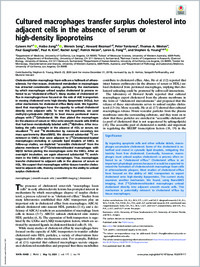Cultured macrophages transfer surplus cholesterol into adjacent cells in the absence of serum or high-density lipoproteins.
- He C Department of Medicine, University of California, Los Angeles, CA 90095.
- Jiang H School of Molecular Sciences, University of Western Australia, 6009 Perth, Australia.
- Song W Department of Medicine, University of California, Los Angeles, CA 90095.
- Riezman H Department of Biochemistry, University of Geneva, CH-1211 Geneva 4, Switzerland.
- Tontonoz P Department of Human Genetics, University of California, Los Angeles, CA 90095.
- Weston TA Department of Medicine, University of California, Los Angeles, CA 90095.
- Guagliardo P Centre for Microscopy, Characterisation and Analysis, University of Western Australia, 6009 Perth, Australia.
- Kim PH Department of Medicine, University of California, Los Angeles, CA 90095.
- Jung R Department of Medicine, University of California, Los Angeles, CA 90095.
- Heizer P Department of Medicine, University of California, Los Angeles, CA 90095.
- Fong LG Department of Medicine, University of California, Los Angeles, CA 90095; lfong@mednet.ucla.edu sgyoung@mednet.ucla.edu.
- Young SG Department of Medicine, University of California, Los Angeles, CA 90095; lfong@mednet.ucla.edu sgyoung@mednet.ucla.edu.
- 2020-05-02
Published in:
- Proceedings of the National Academy of Sciences of the United States of America. - 2020
cholesterol
macrophages
nanoSIMS imaging
smooth muscle cells
ATP Binding Cassette Transporter 1
ATP-Binding Cassette Transporters
Animals
Atherosclerosis
Biological Transport
Cholesterol
Foam Cells
Lipid Metabolism
Lipoproteins, HDL
Macrophages
Macrophages, Peritoneal
Mice
Mice, Inbred C57BL
Myocytes, Smooth Muscle
Serum
beta-Cyclodextrins
English
Cholesterol-laden macrophage foam cells are a hallmark of atherosclerosis. For that reason, cholesterol metabolism in macrophages has attracted considerable scrutiny, particularly the mechanisms by which macrophages unload surplus cholesterol (a process referred to as "cholesterol efflux"). Many studies of cholesterol efflux in macrophages have focused on the role of ABC transporters in moving cholesterol onto high-density lipoproteins (HDLs), but other mechanisms for cholesterol efflux likely exist. We hypothesized that macrophages have the capacity to unload cholesterol directly onto adjacent cells. To test this hypothesis, we used methyl-β-cyclodextrin (MβCD) to load mouse peritoneal macrophages with [13C]cholesterol. We then plated the macrophages (in the absence of serum or HDL) onto smooth muscle cells (SMCs) that had been metabolically labeled with [15N]choline. After incubating the cells overnight in the absence of HDL or serum, we visualized 13C and 15N distribution by nanoscale secondary ion mass spectrometry (NanoSIMS). We observed substantial 13C enrichment in SMCs that were adjacent to [13C]cholesterol-loaded macrophages-including in cytosolic lipid droplets of SMCs. In follow-up studies, we depleted "accessible cholesterol" from the plasma membrane of [13C]cholesterol-loaded macrophages with MβCD before plating the macrophages onto the SMCs. After an overnight incubation, we again observed substantial 13C enrichment in the SMCs adjacent to macrophages. Thus, macrophages transfer cholesterol to adjacent cells in the absence of serum or HDL. We suspect that macrophages within tissues transfer cholesterol to adjacent cells, thereby contributing to the ability to unload surplus cholesterol.
- Language
-
- English
- Open access status
- bronze
- Identifiers
-
- DOI 10.1073/pnas.1922879117
- PMID 32354992
- Persistent URL
- https://sonar.rero.ch/global/documents/169584
Statistics
Document views: 12
File downloads:
- fulltext.pdf: 0
